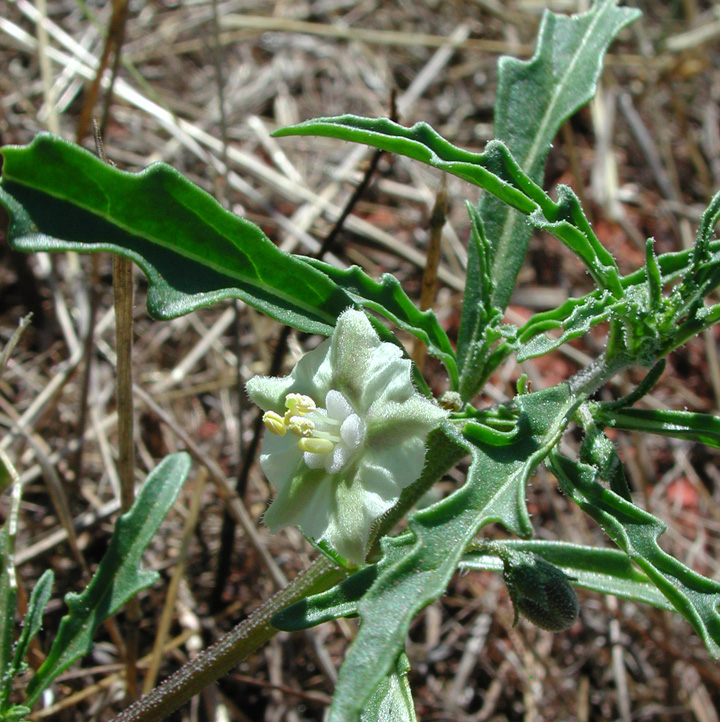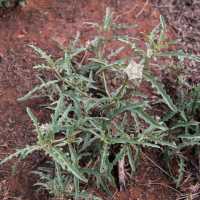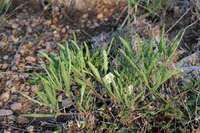- Home
- Search
- Images
- Datasets
- Sample Use
- How to Cite
- Additional Information
- About NEON
- NEON Data Portal
- ASU Biocollections
- About Symbiota
|
|
|
|
Family: Solanaceae
greenleaf five eyes
|
Erin Manton, 2013: Herbs, to 50 cm tall, rhizomatous, glabrous to scurfy, the hairs short, white, branched or stellate, often mixed with longer, tangled hairs (especially on stems, peduncles, and calices). LEAVES linear, lanceolate, narrowly elliptic, or oblanceolate, 1.5–8 cm long, the margins minutely undulate to pinnately lobed and often densely hairy, membranous to subcoriaceous, the midvein prominent; apex acute to rounded-obtuse, tapering to an attenuate, subsessile base. INFLORESCENCES uniflorous, the peduncles 1–3 cm long. FLOWERS with calyx 2.5–6.0 mm long, densely stellate-pubescent; corolla ca. 1 cm wide, the white cushion-like pads contiguous (or nearly so) and almost filling the throat; stamens less than 6 mm long; anthers ca. 1/3 as long as filaments. FRUITS 4–8 mm wide, whitish, pendulous; seeds light brown, alveolate. ––Weedy, found, especially in disturbed areas, dry grasslands, and deserts; all cos. except La Paz; 200–2100 m (700–6900 ft); Mar–Oct; sw U.S. and n Mex.
Manton 2012, Correll and Johnston 1970 Duration: Perennial Nativity: Native Lifeform: Forb/Herb General: Perennial herb, 10-50 cm tall, from slender, more or less woody roots; stems ascending to procumbent, much-branched, especially near the base; herbage sparsely scurfy with coarse white branched or stellate hairs. Leaves: Alternate and subsessile along the stems; blades linear to oblanceolate, 2-7 cm long and 1-10 mm wide, the margins usually pinnatifid with lobes 1-2 mm long, but vigorously growing plants may have leaves with undulate margins. Flowers: Yellow-green to purple-tinged and somewhat showy, on slender pedicels 1-3 cm long from the leaf axils; calyx 5-lobed and bell-shaped, 4 mm long, densely scurfy-pubescent, and enlarging in fruit to wrap around the berry; corolla flat and circular (rotate) or shallowly cup-shaped, 1 cm in diameter, 5-angled and pleated between the angles, pale yellow to greenish-yellow or purple-tinged, with hairy white pillow-like appendages near the base between the stamen attachment points. Fruits: Berries globose, 4-8 mm diameter, whitish, closely wrapped by the persistent calyx; containing light brown, flattened kidney-shaped seeds. Ecology: Found along ditches, roadsides, pastureland, and mesas, below 7,500 ft (2286 m); flowers April-September. Distribution: s CA, s UT, AZ, CO, NM, TX, s OK; south to c MEX. Notes: Chamaesaracha spp. are perennial herbs of the nightshade family; the flowers strongly resemble tomato and tomatillo flowers, with flat, rounded 5-pointed corollas. A distinguishing trait of this genus is the calyx, which enlarges substantially in fruit to wrap around the berry. Physalis (the tomatillo genus) also has this trait, but in Physalis the calyx is papery, bladdery, and much larger than the berry. In Chamaesaracha the calyx remains herbaceous and wraps tightly around the berry. C. coronopus is distinguished from others in the genus by its stems and leaves being sparsely covered with coarse, stellate or branching hairs, never glandular hairs (use your hand lens). C. conoides and C. sordida both have at least some glandular hairs, and lack the branching or stellate hairs. Also, C. sordida has leaves which are entire to only slightly lobed, compared to C. coronopus which usually has distinctly pinnately lobed leaves. Ethnobotany: Used for swellings and ceremonially. Etymology: Chamaesaracha comes from the Greek word chamai, dwarf or false, and the genus Saracha which it resembles and is also in the nightshade family (Solanaceae); coronopous is from Greek korone, crown and pous, foot. Synonyms: Solanum coronopus, Chamaesaracha coronopus var. arida Editor: SBuckley 2010, FSCoburn 2015, AHazelton 2017 |






